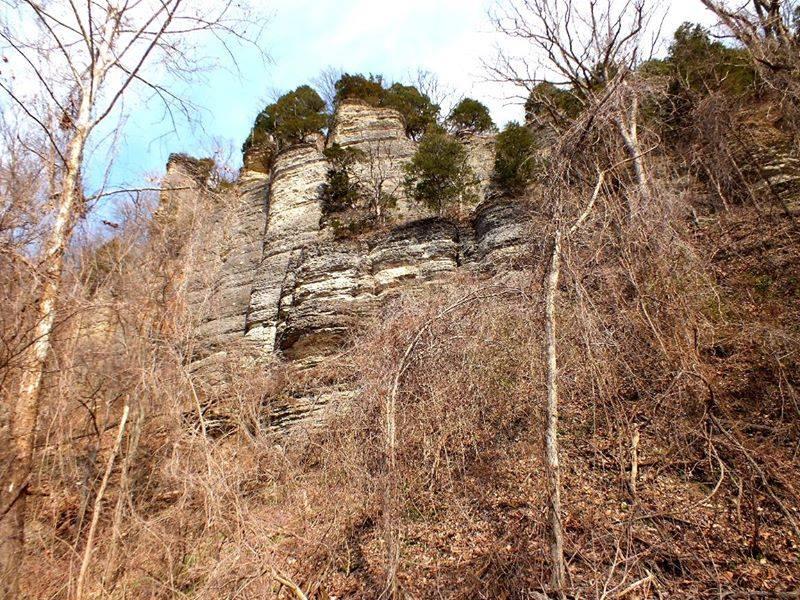
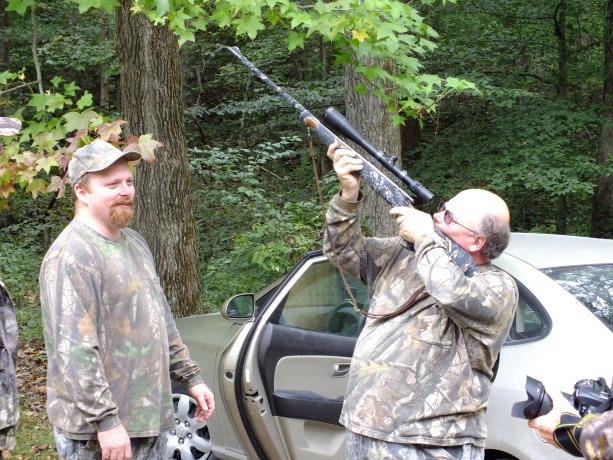
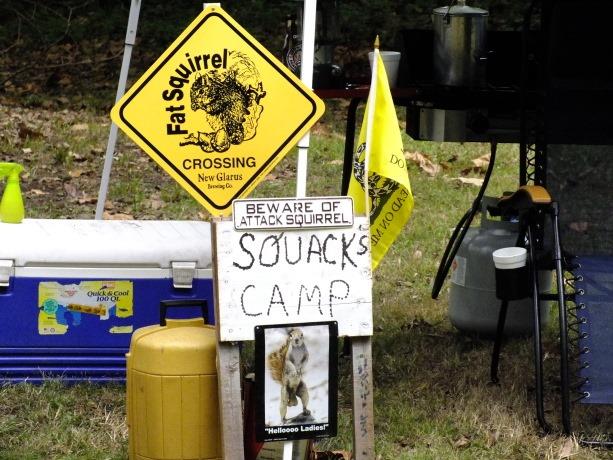
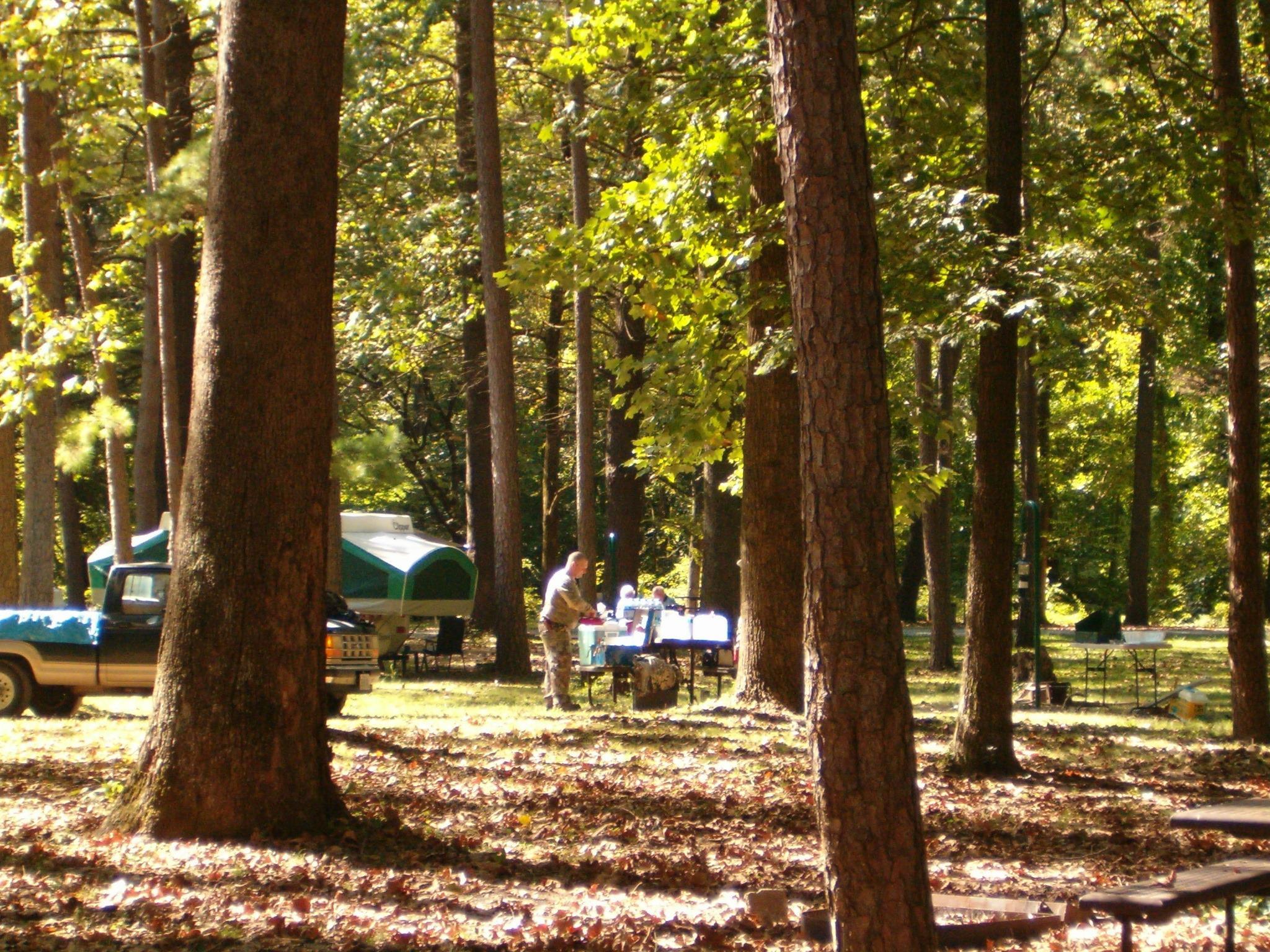
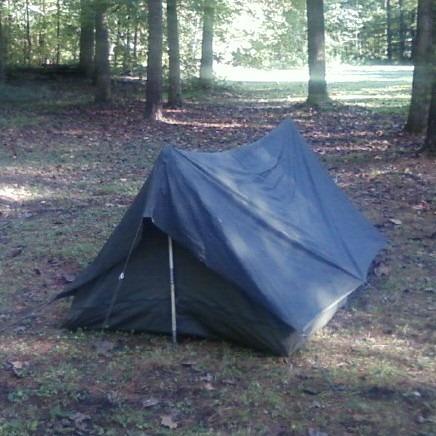
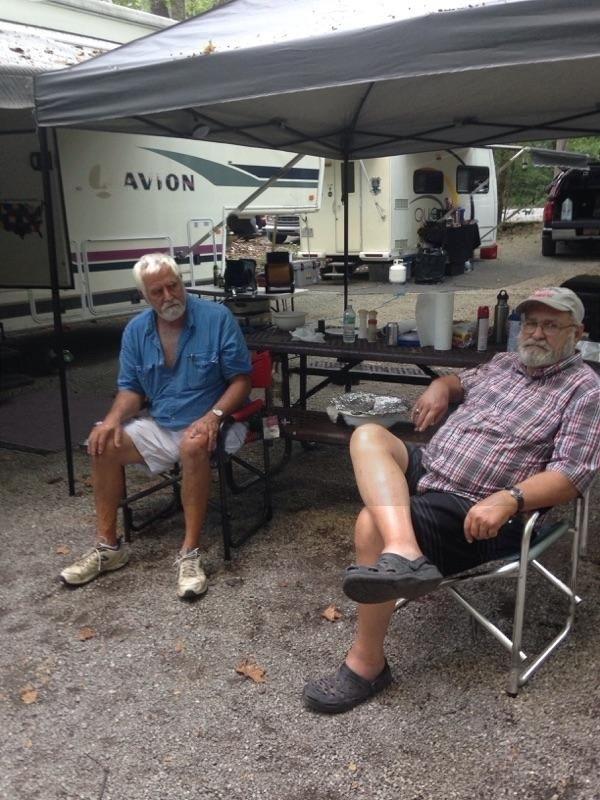
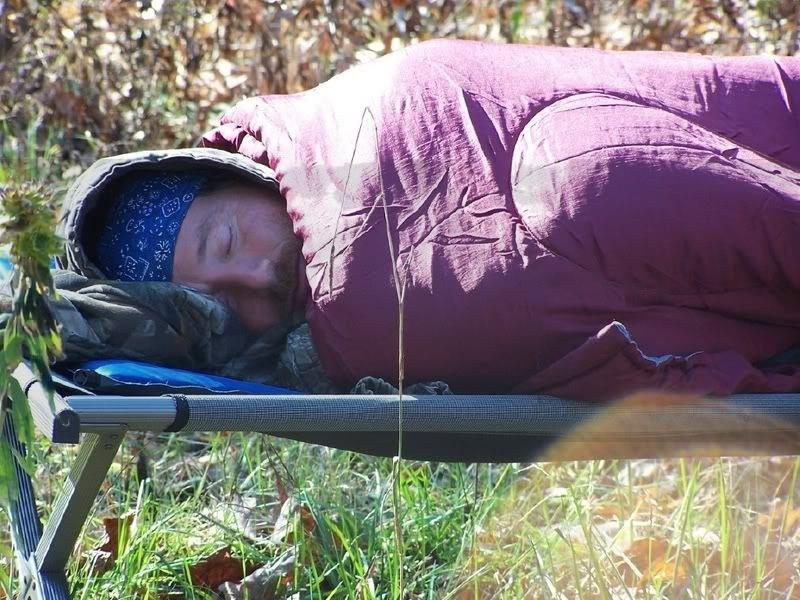
Starting in 2002 with a handful of squirrel hunters,
the annual Shawnee Rimfire Squirrel Hunt now
hosts an average 30 to 50 squirrel hunters each
year, sometimes more. Located in the Shawnee
National Forest and Trail of Tears State Forest in
Southern Illinois, the annual hunt offers many
different types of opportunities for squirrel
hunting. Hunting is as varied as the terrain of
Southern Illinois, which ranges from rocky bluffs
to swampy areas in the bottom lands. The
Shawnee Squirrel Hunt is normally held in late
September, right in the middle of prime hunting.
Depending on the year, you may find squirrels
cutting Hickory, Beech, Acorns, or Tulip Poplar,
depending on the weather and different nut crops produced. Hunters will often have a "honey hole" they
may head to each year and that has proven to produce squirrels in years past. Most of the hunters in our
group prefer to hunt the Gray squirrel that can be found on the ridges and in the more wooded areas. We
do occasionally have hunters that are seeking Fox squirrels that although the food sources are the same,
are more likely to be in the bottoms or along the edges of the timber.
Rimfire rifles are the preferred firearm of the majority of squirrel hunters in the area. Rifles chambered in
.22 and .17 calibers are good choices for squirrel hunting, being moderately quiet and able to harvest
squirrels at different ranges from a few feet to over a hundred yards depending on the rifle's accuracy,
chosen cartridge, and the skill of the hunter.
Hunting techniques may vary depending on what time
of the year you may be hunting. Illinois squirrel season
opens August 1st and runs until February 15th. I find
late August until mid-October to be the prime time to
squirrel hunt in my area for my style of hunting.
Hickory, Beach, Tulip Poplar, Oak, as well as other
food sources are normally abundant this time of year
and squirrels may move freely from tree to tree in
search of their meal of choice.
More often than not, I will walk slowly and as quietly as
possible thru areas that I have pre-scouted for trees
bearing nuts or for areas with as much mast as
possible. When entering the area, move slowly and
listen, your ears may reveal more squirrels than your
eyes do. Feeding squirrels make a variety of noises to
listen for. From squeaks to barks, to the scratching of claws on bark, teeth scraping the hull of a nut,
limbs and leaves moving under the squirrels weight as he moves along, dry leaves rustling as they move
along the ground, and even the dropping of "cuttings" may reveal the squirrels location. When you spot a
squirrel you have a few options to think about. Should you go right after that squirrel, if so what is the best
approach to take, or should you wait to see if other squirrels are in the area? Personally, I prefer to wait a
short while, using the time to find my path of approach, a possible tree that I can use to steady my shot,
and to see if there are more squirrels in the area. More than once a hunter has been so focused on his
target that he fails to see other squirrels that may bark a warning, giving away your location. When having
decided to move closer or to get a better angle on the target, move slowly and deliberately trying to keep
some form of cover between you and the squirrel. If you have waited and checked out the path, you know
what lay between you and the squirrel. You may very well be able to avoid awkward moments like stepping
on a stick, bunch of dry leaves, or having to "reroute" mid stalk to avoid an obstacle.
If you were successful in your stalk, it's time to
harvest the squirrel. Make sure you have the best
rest possible and that your line of sight and shot is
unobstructed, remember that if using a scope,
the actual bullet path may be 1" or more lower
than the crosshairs of your scope at close
distances. It's a good practice to put your fingers
or thumb between the firearm and your intended
rest, first it keeps the firearm from getting scarred
up from the bark and may keep the firearm more
steady after the shot. In addition to the previous
reasons, if you are using a semi-auto rifle if the
charging handle of the action is against the tree it
may cause the rifle to spring away from the tree or
even damage the rifle itself. When you've got the
squirrel in your sights or scope, pick your shot. If
you've moved up on the squirrel, you'll have a bit of time to get prepared. Steady your breathing, find the
spot on the squirrel you're going to aim at, remember... aim small, miss small. Slowly squeeze the trigger
until the shot goes off, remember to follow thru with your shot, and try to maintain your sight picture after
the shot. When the squirrel falls, don't rush over to retrieve it immediately if at all possible. It is quite
possible that the squirrel may have a few involuntary kicks and twitches, but if the shot was good, it should
quickly expire. If the squirrel still appears to be not to be fatally wounded a quick follow up shot from your
position should quickly and humanely dispatch it. Running after the squirrel will only push him to flee at a
faster rate. Running with a firearm should not be done and could end up with injury or worse. If the target
has been humanely dispatched, remain still for a few minutes, the shot may have caused other squirrels to
move or to bark giving away their location and offering another target.
After having retrieved your squirrel(s) it is preferred to
field dress them as soon as possible. Squirrels are
easier to clean when they are fresh. I always carry a
couple of plastic bags to keep the meat in to keep it
clean and protected. I will cover how to field dress a
squirrel, complete with a video in the "Squirrel Hunting
Stories, Tip, and Tricks" Page.
Camping during the squirrel hunt is one of the things
that I look forward to the most. The majority of the
squirrel hunters camp at Pine Hills Campground, near
Wolf Lake, IL, although a few do stay at hotels in
nearby Anna or Jonesboro. Pine Hills Campground is
primitive camping campsites, complete with a fire ring,
pole to hang your lantern on, and a picnic table. The sites are well maintained, with ample parking
available. Campground amenities include a pavilion as well as two vault toilets and a few trash bins located
throughout the campground for convenience. The entrance road to Pine Hills is well maintained rock, so it
can get a bit dusty with people traveling in and out. Wolf Lake is a small town a few miles away from Pine
Hills and has a restaurant "The Duck Inn", if you need ice or would prefer to have an indoor sit down meal.
Ware is located a little farther south and has a "farmers market" and a few necessities. Anna-Jonesboro
are medium size towns with gas stations, restaurants, convenience stores, big box stores, groceries, and
most anything else you may need. Fortunately Pine Hills Campground doesn't get much cell service, but
the surrounding towns all have fair cell service if you need to make a call or check messages. Pine Hills is
a well shaded place to slow down and enjoy nature.
Several of the folks camp in various styles of tents ranging from multi-room tents complete with attached
screen rooms to ultralight one man tents. I personally have camped at Pine Hills in a six-man cabin tent, a
truck with a topper on it, the back of an SUV, a
simple "pup tent", and most recently have
discovered and enjoy hammock camping. Some
regulars to the hunt bring fifth-wheel campers,
motorhomes, pull behind campers, overland roof
top camping setups, converted vans, or plethora
of different shelters they deem comfortable
enough for them. As mentioned before, some
folks stay at local hotels and show up at camp in
the early hours of the morning for coffee, a quick
visit, or to possibly meet up with a hunting buddy.
Some hunters from the area do the same,
showing up early before the hunt, or after the
morning hunt, sometimes spending the day at
camp hunting in the afternoon/evening hours.
Night normally comes pretty early at squirrel
camp, with some hunters getting up well before dawn to travel to their chosen hunting spots. At the
extreme far end of the camping spectrum are those that simply "camp" in the open, sleeping either on the
ground or on a cot. Some with tarps above them and some sleep just fine under the stars. A few that have
discovered the hunt by accident when traveling thru have even spent a night or two roughing it reclined in
the front seat of their car.
During the last two decades that I have been attending the Shawnee Squirrel Hunt, I have seen a lot of
different things at camp, the most prevalent is the comradery and welcoming attitude of the group. More
than once I have seen a person that was traveling thru and discovered the hunt and living too far away to
go home, get their gear together, and return to hunt completely outfitted by numerous hunters in order for
the stranger to stay and hunt. I have seen hunters loaned hunting clothes, firearms, shelter, and food all
while sharing a campsite with someone already setup. Normally these hunters will return the following
years and become one of the regulars at camp, oft times bringing their friends or relatives with them in the
years to follow.
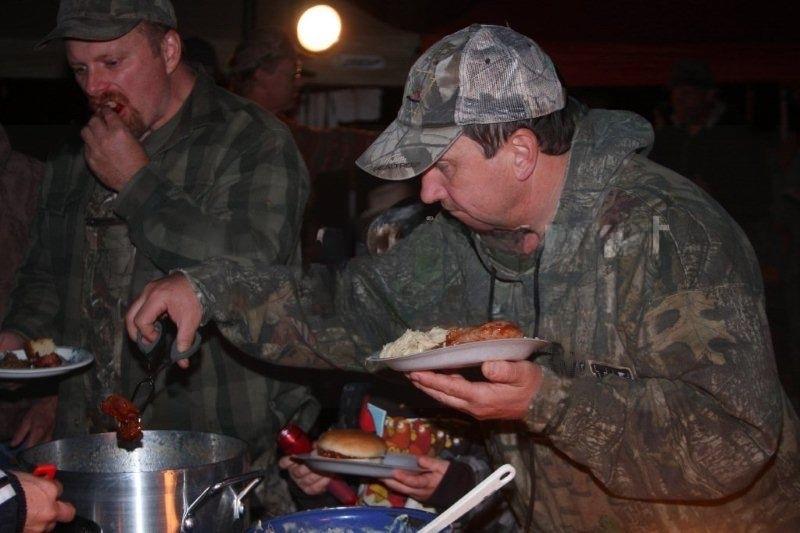
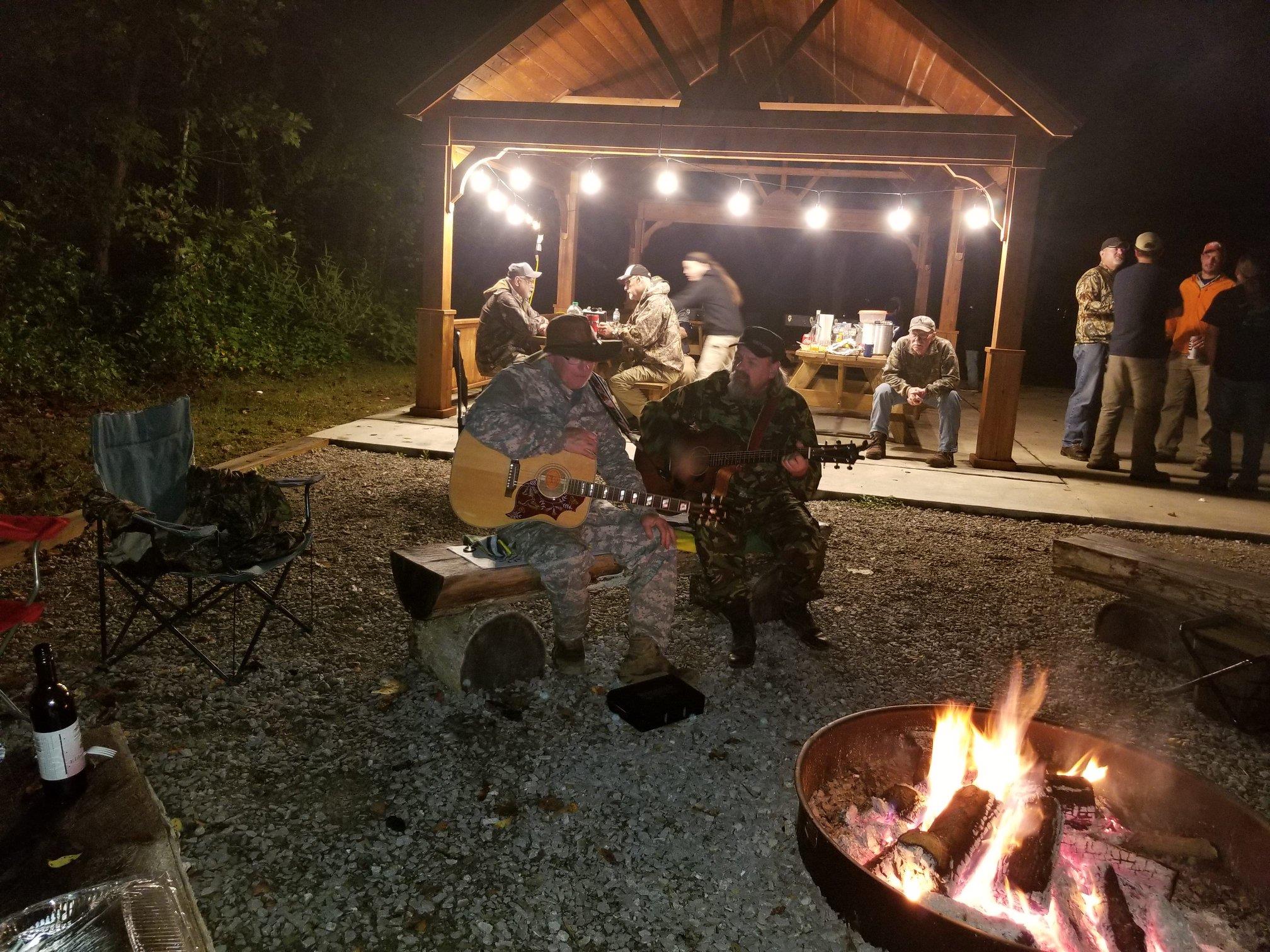
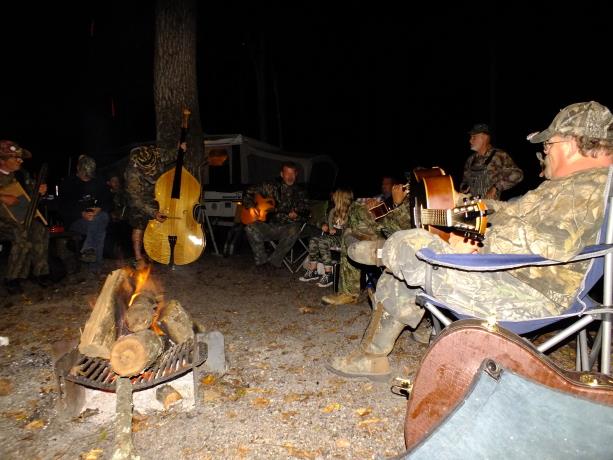
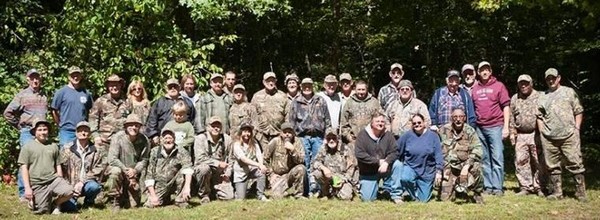
During the middle of the day when the morning hunt is over, socializing with friends and other hunters
becomes a top priority. Topics from the days hunt to solving the world’s problems are cussed and
discussed with the exception of politics and religion. Along with the talk you may find yourself in a game of
chess, checkers, or throwing horse shoes to pass the heat of the day. You may also find yourself sitting
at someone's camp telling or listening to stories of years gone past over an occasional adult beverage or
two, or of new rifles or equipment purchased since the last hunt. As the day wears on, several of the
hunters gather equipment to go for an afternoon hunt.
Saturday night is often the peak of yearly squirrel
camp, when everyone gathers for the "carry in" supper
that happens each year. People carry in an array of
different dishes, a lot made with wild game, such as
wild turkey, venison, elk, and of course squirrel. I
would not attempt to name all the dishes and foods
that I have seen served, often four to six picnic tables
filled edge to edge with food fit for royalty. After the
meal and things are cleaned up a bit, we all gather
together for the entertainment portion of the hunt. Live
Music!!! There are all kinds of instruments and
musicians present and everyone is welcome to join in
the food and festivities even if you're just camping and
not one of the squirrel hunters or just passing thru the
Pine Hills camp. The festivities normally end anytime from 11:00 to the wee hours of the morning and you
can sure feel it about 5:00 the next morning. Many of the hunters still make it up early for hunt Sunday
morning, or at least early enough to get involved in the iron sights contest that begins around 2:00 PM
Sunday afternoon ending approximately at sundown. When all the hunters have returned to camp, the
winner is decided and the years bounty of prizes have been awarded to the lucky winner. Hunting squirrels
with iron sights takes not only luck, but a lot of skill as well. Often one squirrel is all it takes to win the
contest with as many as a dozen or more hunters
participating in the hunt. To get close enough to
harvest these timid gray squirrels takes a lot of
time and patience in order to even get a shot at
one. In the event of a tie, the hunter with the most
"head shot" squirrels is deemed the winner. Past
prizes have ranged from squirrel hunting "gag"
gifts to very high end skinning knives. Among the
knick-knacks are often very useful hunting items
and gear such as game and ammo carriers,
compasses, camping gear, hunting and squirrel
memorabilia, tools, firearm maintenance items,
and much, much more. The most valuable prize
are the bragging rights for the year. After the
presentation of prizes and the reigning of the next
years iron sights winner, those that are going to
leave or leave the next morning say their goodbyes and well wishes to those that may be out of camp
hunting the following morning when they depart. Groups of friends and hunters will shuffle off into smaller
groups for supper, to sit around the campfire and visit, or to play a little more music before calling it a night
and heading to their respective campsites to retire. Although the hunt continues until Wednesday, several
of the hunters leave Sunday night or early Monday morning due to their schedules.
Having been to all except the first Shawnee Squirrel
Hunt I have made some wonderful lifelong friends and
shared some unforgettable memories with them.
Folks with names like: Squacks, Sarge, Taff, Tick
Magnet, Reb, Doc, Patience, Keeper, Bowdog and
Godzilla, Rusty Nuts, Cool Breeze, Pot-Shot, 22 Man,
Semo, Frank Buck, Nobody, Crow Feather, Bolt
Action, Poison Ivy, Buford, Knotty Bumpo, Kap'n Ken,
Bottoms, TFrank, Stumpy, and many more throughout
the years, some of the names I may have forgotten, I
will always remember the people. Occasionally when
the stars aligned just right and when a camera was
close at hand, we all got together to take a group
photo or two throughout the years.
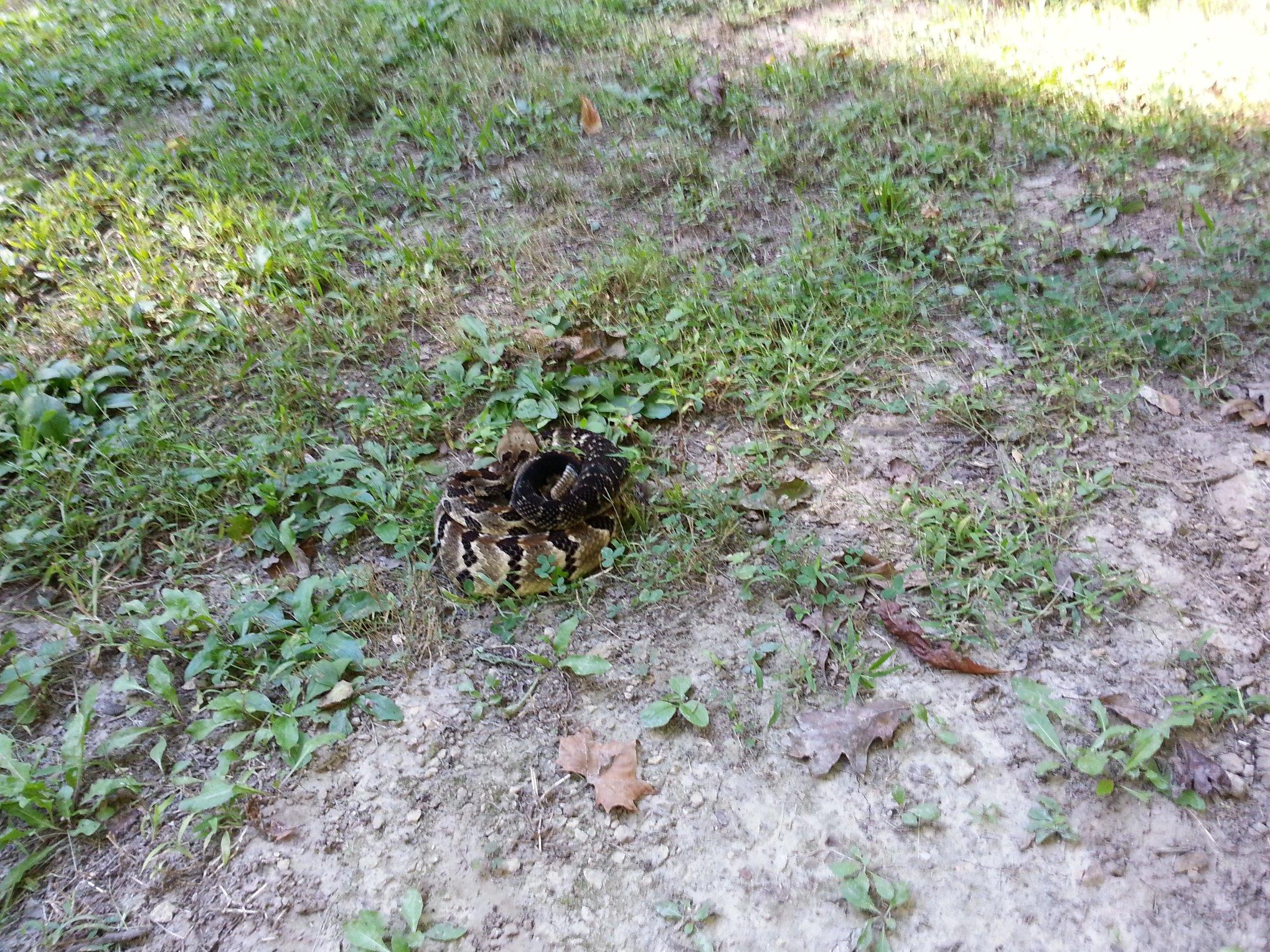
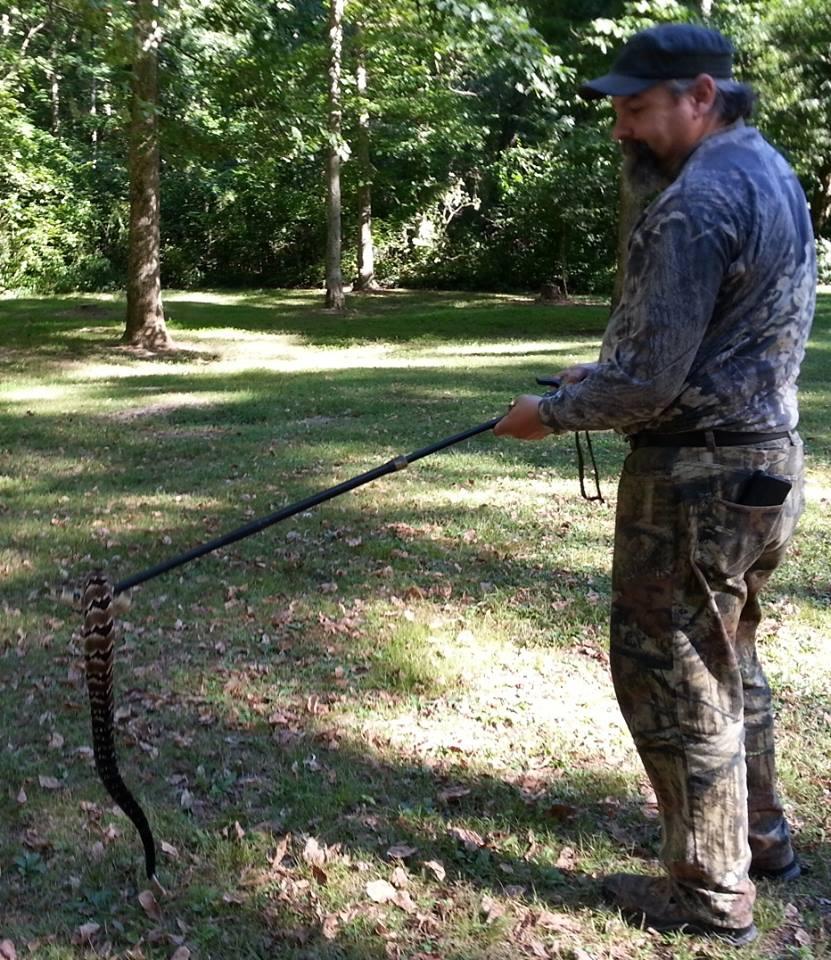
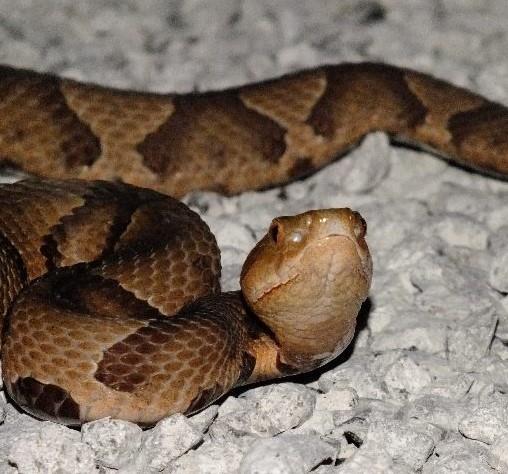
On a rare occasion that we do happen to have an
unwelcome visitor at camp, we politely escort
them to the edge of camp. These visitors
commonly include a raccoon, possum, or even an
armadillo, rarer are the Copperhead and Timber
Rattle Snake that happen to venture into the
camping area. As far as I am aware other than
being startled by, or just the general dislike of
snakes, no one has been bitten or injured by any
of the snakes they have encountered.
Commonsense should always be exercised,
watch where you're stepping, don't go reaching in
blind holes, or just generally being cautious when
gathering firewood will go a long way in keeping
you safe. If you should venture upon a one of the
snakes, simply give it a wide berth, it doesn't want to be around you anymore than you want to be around it.
Most will simply slither off in what they consider a safe direction. Snakes are more intelligent than some
folks think, producing venom takes a lot of energy and they don't want to waste it needlessly on something
they don't intend to eat. If you are snake bitten, there is a fair chance that it may be a "dry" bite and no
venom is injected. Regardless if you are bitten, make sure that you identify the species of snake that bit
you. Don't endanger yourself trying to capture the
snake, they will defend themselves and you may
possibly be bitten again attempting to capture it. Even
though cell service is spotty at best in some areas,
the camera on your phone should still work just fine.
Remember that when retrieving squirrels that may not
have expired immediately that they may try to hide in
the same area that a snake has chosen to occupy. As
stated earlier, don't carelessly chase down a
wounded squirrel when a follow up shot from a safe
distance can be taken. If you do find it necessary to
remove a snake from your camping area, do so with
caution. Most snakes would prefer to flee rather than
fight, so the majority can be "herded" using a long
stick, hiking pole, or something similar. Most snakes
have a striking distance of approximately on third of
their body length, so stay out of their strike range.
Once the snake has been removed from the area
there is little chance they will return. Remember that
snakes are protected in most state and national parks, so killing or harassing a snake may be illegal and
result in you being asked to leave the park, fines, or other penalties that would ruin your camping trip.
Although the chances are you won't see a snake, let alone on that is venomous, there are other insects
and critters that can be dangerous or a nuisance. Ticks, chiggers, mosquitoes, buffalo gnats, and others
can not only be extremely annoying, they may transmit diseases such as Lyme disease or West Nile
Virus. Make sure to use some sort of insect protection of your choice, some people use repellents with
Deet, Picaridin, or other ingredients. Apply the repellent often and make sure that you cover all areas that
are exposed. Permethrin on your clothes also helps keep the unwanted guests off or away from you. On
another note, sometimes during warmer weather you may choose to wear lighter garments that although
cooler may allow insects to bite thru the material.
Having slept in a hammock during several of the
hunts I have learned that mosquitoes can
penetrate the hammock material where your skin
makes contact with the material, even with a bug
net enclosing the hammock. Permethrin sprayed
and allowed to dry on the hammock material will
help to stop this from happening, resulting in a
more pleasant night’s sleep. Make sure to spot
test anything you may douse your hammock with
to make sure that it doesn't damage the material, I
would not use anything containing Deet on nylon
as it may cause it to "melt". With that said, if using
Deet on your skin, I would rinse off before getting
in your hammock. I have seen no damage to my
personal equipment using the Permethrin or
Picaridin thus far, your results may vary. Camp is
not the place to discover what does or doesn't damage your equipment. Test at home first.
Raccoons, Possums, armadillos, and other things that go bump in the night. It's long proven that rabbits
and Grizzly Bears all sound the same in the dark, with that said it's quite possible that you will hear a
myriad of sound you may not recognize at night. Birds, frogs, and mammals that are or become more
active at night play a chorus of sounds to fall asleep to and after a night or tow even become calming.
Unlike the sounds of your trash being ripped apart by a raccoon and acclimated to the food resources
garbage or food left out on tables may provide. Raccoons and Possums are not solely to blame for this
behavior, some campers or park visitors may actively feed these critters as they think they're cute and that
they are helping nature feed its inhabitants. It's actually has quite the opposite effect on the animals as it
conditions them not only to take advantage of the handouts, but to sometime aggressively seek them out.
When this occurs park officials are often notified and the animal is humanely dispatched for safety
reasons. Raccoons and other animal can carry many different diseases such as rabies, distemper, or
others that may be transferred or effect the campers themselves. Other issues involve damage or losses
caused by the visitors, such as food being taken or ruined, coolers damaged, unsecured shelters being
wrecked inside, or worse yet being trapped inside and becoming irritated and aggressive when
discovered. If you see an animal in the park, remember that it is their home and you are the visitor, if the
critter isn't acting normally stay away from it and notify park officials. One last note, if you find a baby
critter, its most likely not abandoned and the mother may well return if you leave the area, let nature take its
place and please don't interfere.
Please check out the rest of the Scattergun Outdoors Website where I will cover more on camping and
equipment needed at Shawnee National Forest as well as other places and different types of camping,
hunting, hiking, equipment and techniques for each one, and generally enjoying your time outdoors.
